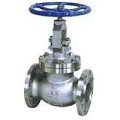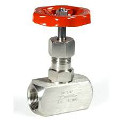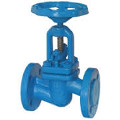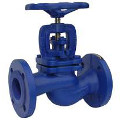



Our shutoff valves which are usually supplied in the "globe" type and in the "directional flow type", are suitable for interception and for modulation as well.
In these types of valves the seats are formed by a ring seat and a shutter which can be differently shaped as necessities require (disc, conic or needle shaped; with interchangeable gasket, etc..). The shutter can be linked to the operating stem in such a way that it undergoes a pure transitional motion without rotating together with the stem, thus avoiding any wear or scratch on the seat due to friction between shutter and seat. With these valves the bonding of shutter and seat, due for instance to calcareous deposit, is avoided, and even at high temperature there are no interferences between shutter and seat.
For big sizes and high temperatures the operation is made possible by the use of a by-pass or a balanced shutter. The latter is made up by a main disc and on auxiliary disc assembled inside it. The valve is installed with reverse flow direction, so that the pressure is applied over the disc, thus helping the sealing.
During the opening phase, the operating stem acts on the little auxiliary disc before, and when the pressures inside the valve are balanced the main disc is actuated. The seats are placed approximately on the inlet and outlet flanges axis, thus avoiding the deposit of solid particles that the flow may drag on the piping bottom and which could undermine the sealing.
The operation stern is always movable and its thread side is usually placed outside the gland, not in contact with the fluid which may cause damage to it; besides, the stem position can visually indicate the valve opening degree.
The yoke nut is usually held by a yoke having two arms particularly elastic, so that the thermal expansion cannot block the valve in the close position.
The disc frequently has an auxiliary seal seat, which (at open valve) matches a seat obtained from the inside top of the bonnet.
The backlocking is thus made possible, which allows the gland gasket replacement with fully open valve.
The gland is usually "cap" type for small sizes and bronze valves; it's "eye-bolts flange type" for steel valves and big sizes, thus allowing a constant pressure on the gaskets, even when the bolts tightening is not homogeneous.
In respect to other valves or gates, the flow is usually not bidirectional.
Because of the tortuous way, the flow pessure drops are higher than with a free flow valve.
